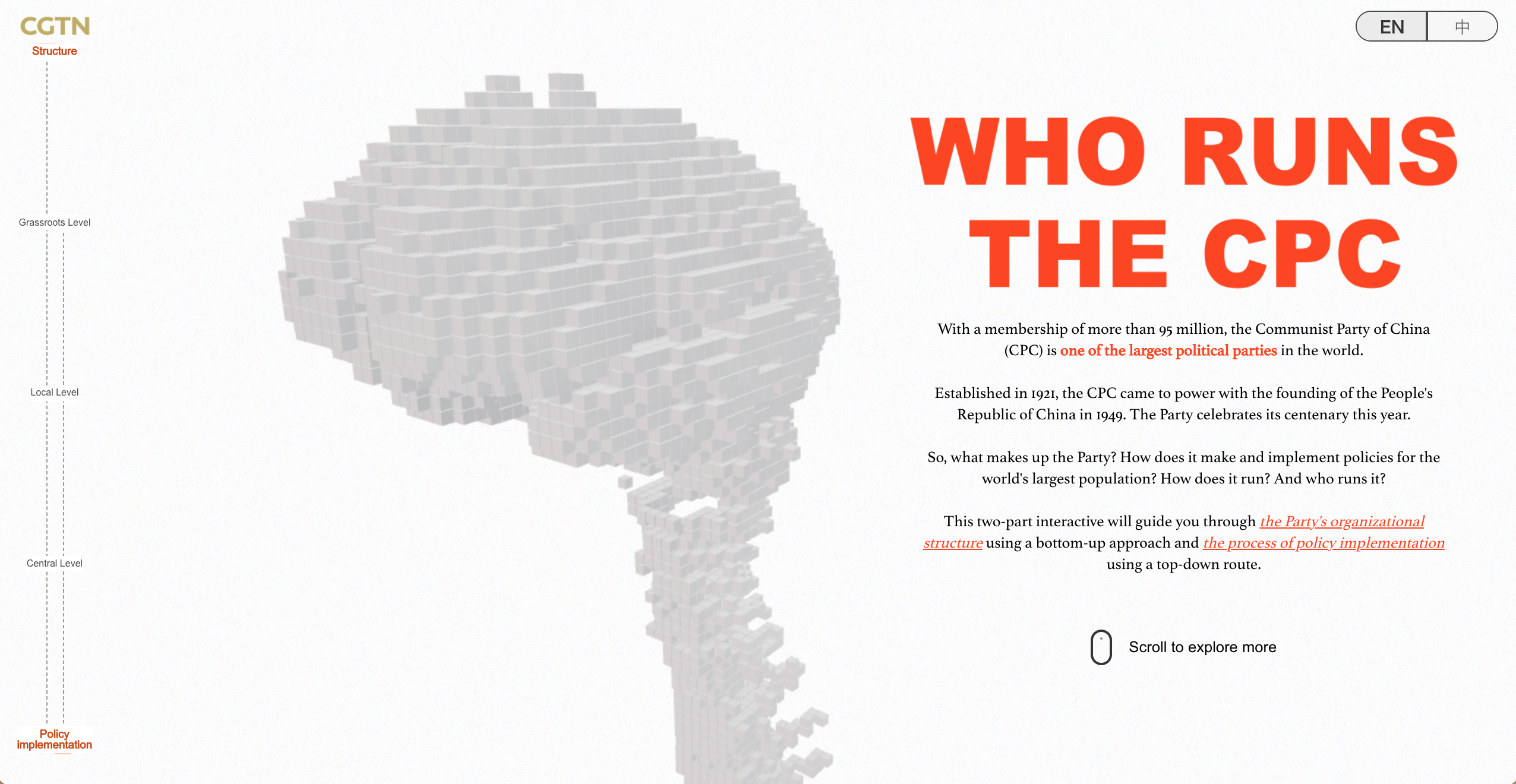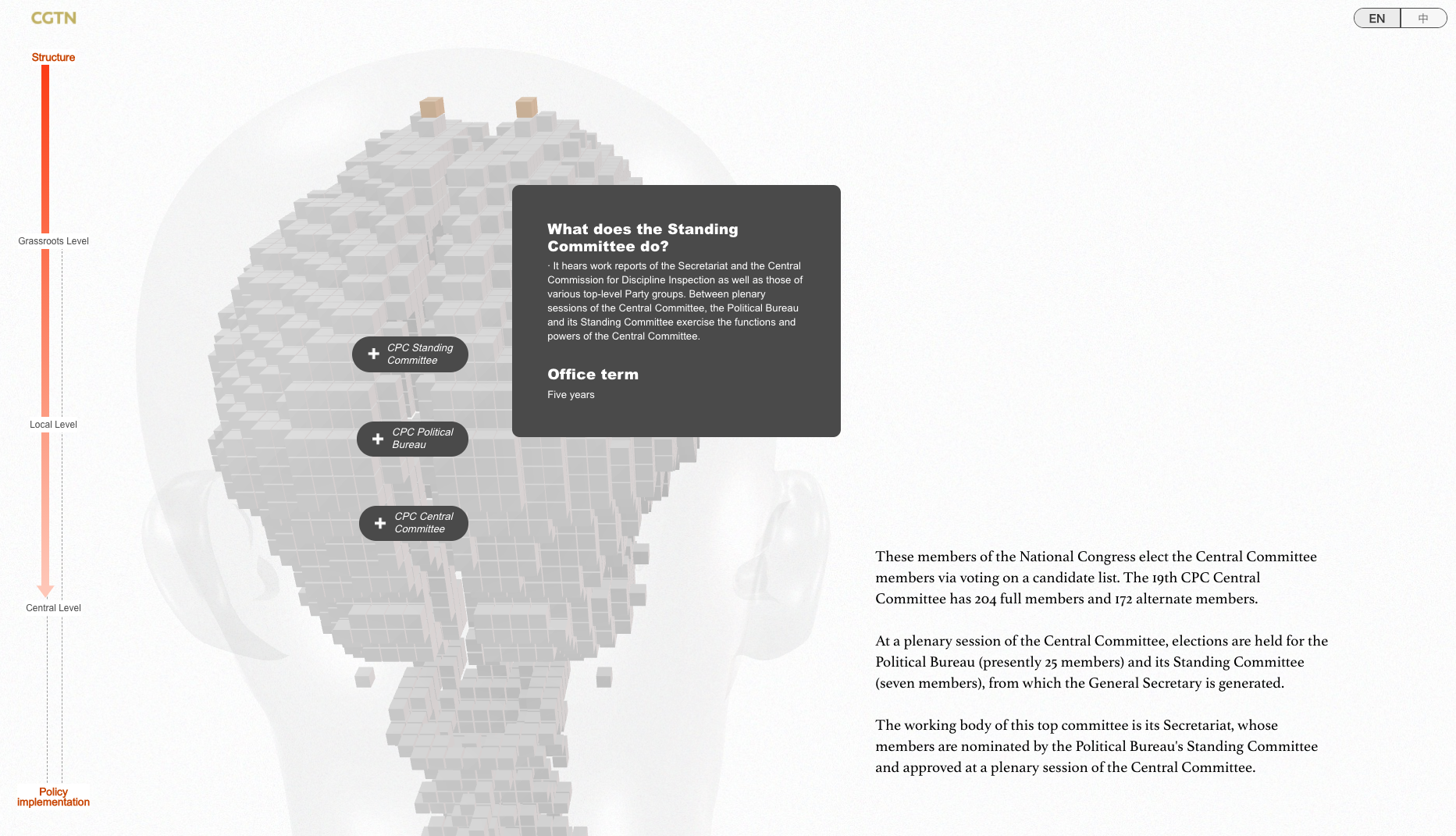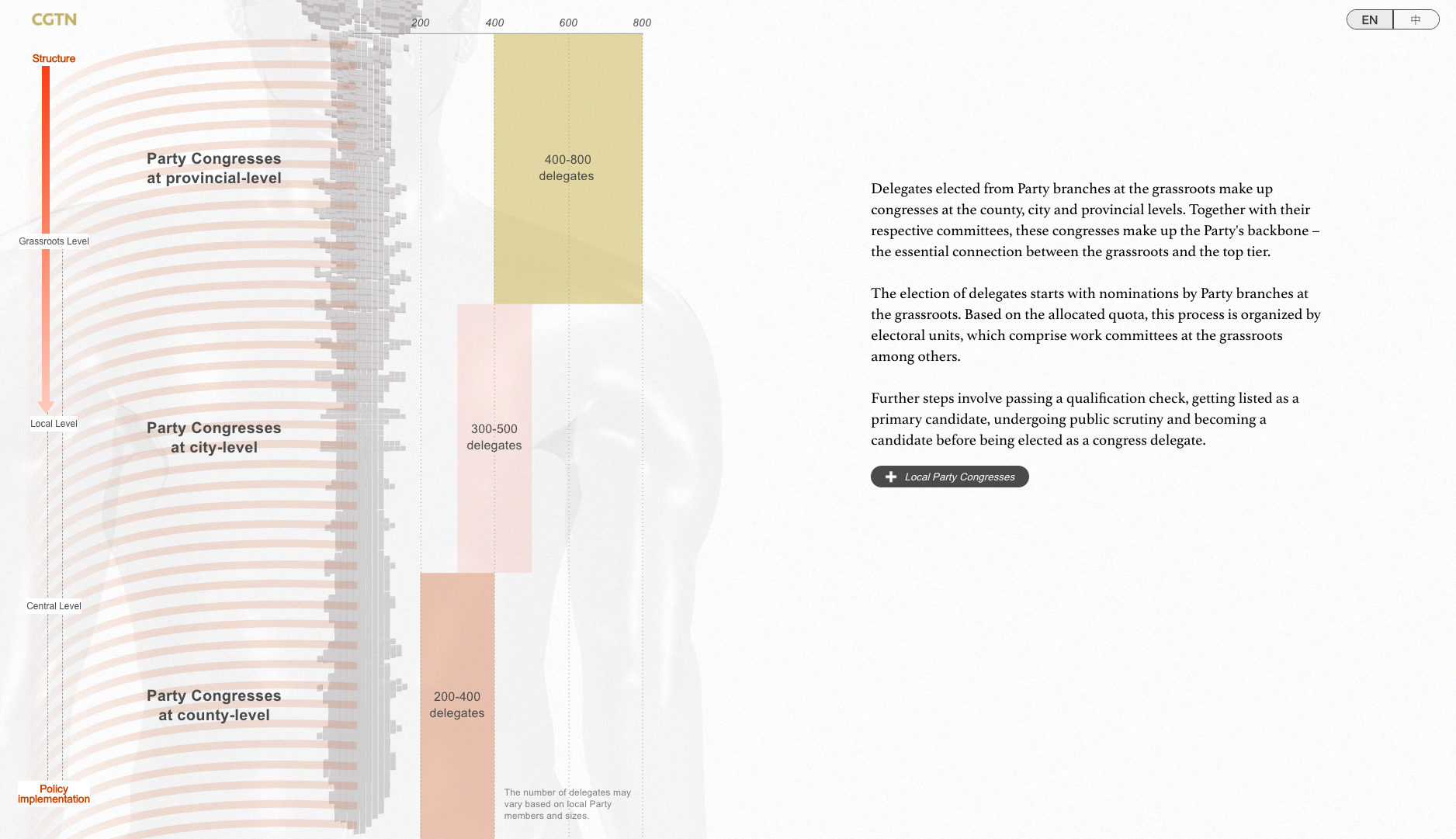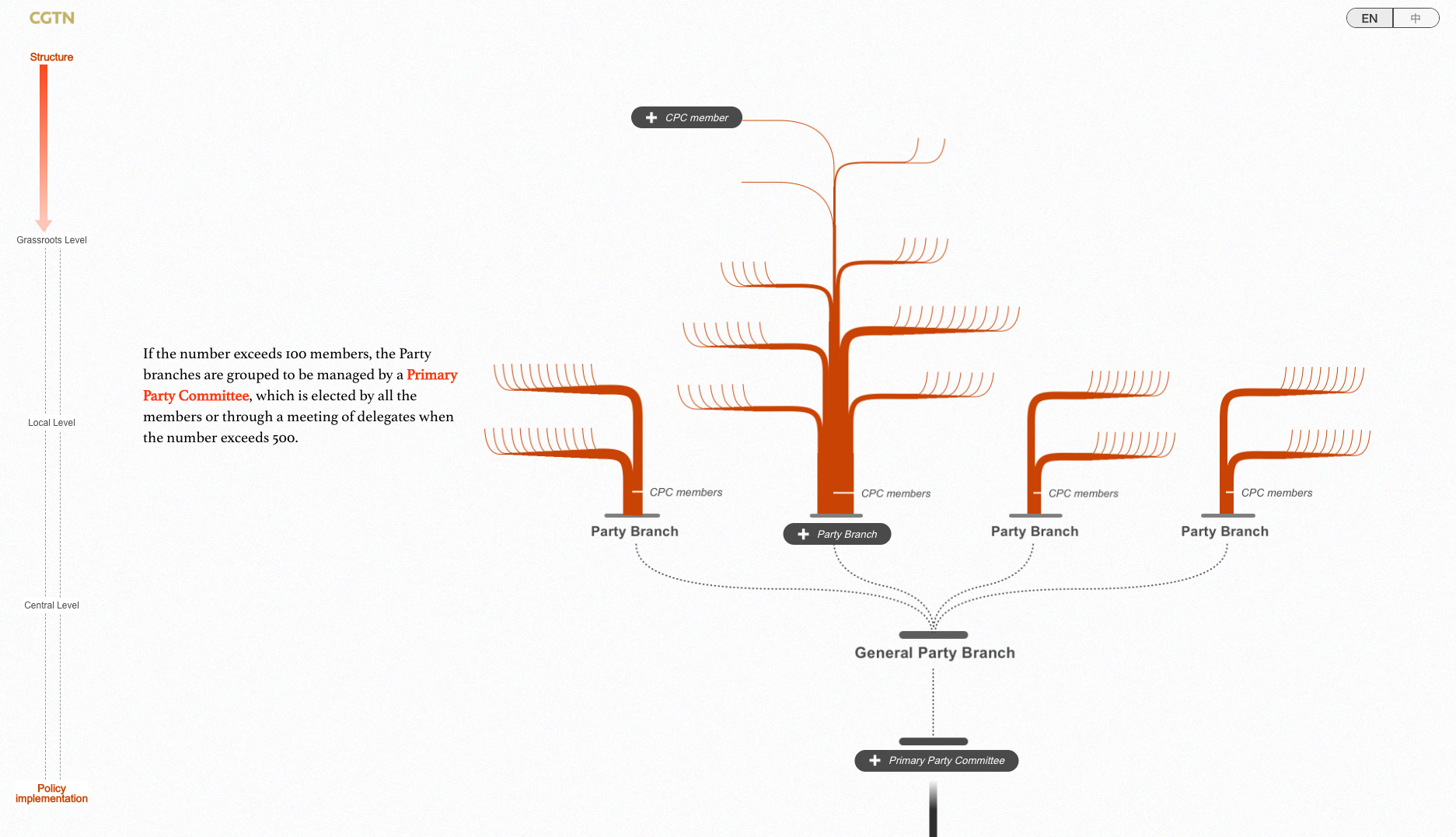If one is to understand who runs the Communist Party of China (CPC) – a century-old party leading the world's most populous country, it is essential that one understands what makes up the Party and how it operates.
So, let's use an analogy to understand the Party's structure and how it functions: The Party is to China what the nervous system is to a human body.
Access CGTN's interactive page: Who Runs the CPC
From what could be called lifesaving reflexes and information transmission to carefully crafted decisions and the very basis of consciousness, the Party performs a range of functions that bear a striking resemblance to those of a nervous system. And it is pretty much structured that way.
The Party organizations can be broadly classified into three tiers: the central (the brain), the local (the spinal cord) and the grassroots (a network of nerves and neurons) levels.

Screenshot of CGTN's interactive project "Who Runs the CPC"
Screenshot of CGTN's interactive project "Who Runs the CPC"
'The brain'
The central tier comprises the top decision makers – the CPC National Congress and its Central Committee, which serve as the Party's brain. They are the highest decision-making organs of the Party, making proposals for the entire country's socioeconomic development.
The National Congress is convened by the Central Committee once every five years. At an annual plenary session of the Central Committee, elections are held for the Political Bureau (presently 25 members) and its Standing Committee (seven members), from which the General Secretary is generated.
As for the Central Committee itself, its members are elected from the National Congress, whose delegates are elected from electoral units – a majority of which are divided by region, such as provinces, autonomous regions and municipalities, while the rest come from various bodies under the Central Government. A total of 2,280 members made up the 19th CPC National Congress in 2017.

Screenshot of CGTN's interactive project "Who Runs the CPC"
Screenshot of CGTN's interactive project "Who Runs the CPC"
'The spinal cord'
Under the CPC National Congress, at the provincial, city and county levels, there are congresses that function like the spinal cord in a nervous system.
A provincial Party congress has 400 to 800 delegates. A Party congress at the city level has 300 to 500 delegates, while the number is between 200 and 400 for the county level.
These congresses are held every five years, but the plenary sessions of their respective committees are convened at least biannually.
The delegates to these congresses come from the grassroots. The election process starts with nominations by Party branches. Based on the allocated quota, this process is organized by electoral units. Further steps involve passing a qualification check, getting listed as a primary candidate, undergoing public scrutiny and becoming a candidate before being elected as a congress delegate.

Screenshot of CGTN's interactive project "Who Runs the CPC"
Screenshot of CGTN's interactive project "Who Runs the CPC"
'Nerves and neurons'
Under the local Party congresses are the branches at township, village and neighborhood levels. They weave the elaborate web of nerves which are brought to life by neurons – over 95 million CPC members as of June 5.
These "nerves and neurons" operate at the level of urban and rural neighborhoods up to the level of townships, government organs, state-owned enterprises, public institutions, schools, social and economic organizations and military units. In this way, they cover the grassroots of the Chinese society.
Mainly, the members operate in Party branches and general Party branches, which are managed by their respective committees.
Three members make a Party Branch, which may have a committee if the number of members is between eight and 50. And several Party branches with a collective membership between 51 and 100 are grouped into a General Party Branch, which too is managed by its own committee.

Screenshot of CGTN's interactive project "Who Runs the CPC"
Screenshot of CGTN's interactive project "Who Runs the CPC"
If the number exceeds 100, the Party branches are grouped to be managed by a Primary Party Committee, which is elected by all the members or through a meeting of delegates when the number exceeds 500.
As of June 5, there were 4.86 million grassroots CPC organizations across the country.
Simply put, members at the grassroots report the situation on the ground to mid-level organizations that summarize and review the inputs before the top leadership makes decisions, which are then implemented from top to bottom at all levels.
What do 'neurons' do?
The CPC members carry out a range of tasks. For example, they undertake community service projects, such as poverty alleviation, mediation, donations, elderly care and environmental protection. They also actively engage in emergency relief projects, such as flood relief and COVID-19 response.
The resounding success achieved by China in terms of poverty alleviation couldn't have been possible without these neurons on the ground. Many of them were dispatched to poverty-hit areas where they helped with infrastructure construction, boosted employment and economy via trainings, improved people's living conditions via residential renovation and guided villagers to capitalize on their indigenous advantages, such as expertise in farming or craftsmanship, so that they not only escape poverty but also stay out of it.
At the same time, as the Party's lifeblood, they vote in Party elections and offer suggestions and critiques on policy matters, all the while studying and implementing the Party line, principles and resolutions.
In a nutshell, the "brain" makes the policies based on inputs from these "neurons," who are then responsible for all the action. Essentially, it is them who run the CPC.
Credits
Editors: Moosa Abbas, Zhao Hong, Shi Tao, Nie Zheng, John Goodrich.
Chief Editor: Chen Ran.
Data Editor: Zhou Rui.
Graphic Designers: Wu Haixia, Liu Shaozhen.
Visual & Interactive Designer: Li Yixiao.
3D Engineer: Tian Yu.
Senior Interactive Engineer: Bi Jiankun.
Consultants: Xia Jixuan, Zhang Xixian, Xia Lu.
Multimedia Producer: Xu Jiye.
Producer: Si Nan.
Managing Director: Zhang Shilei.
Supervisors: Fan Yun, Ma Jing.

